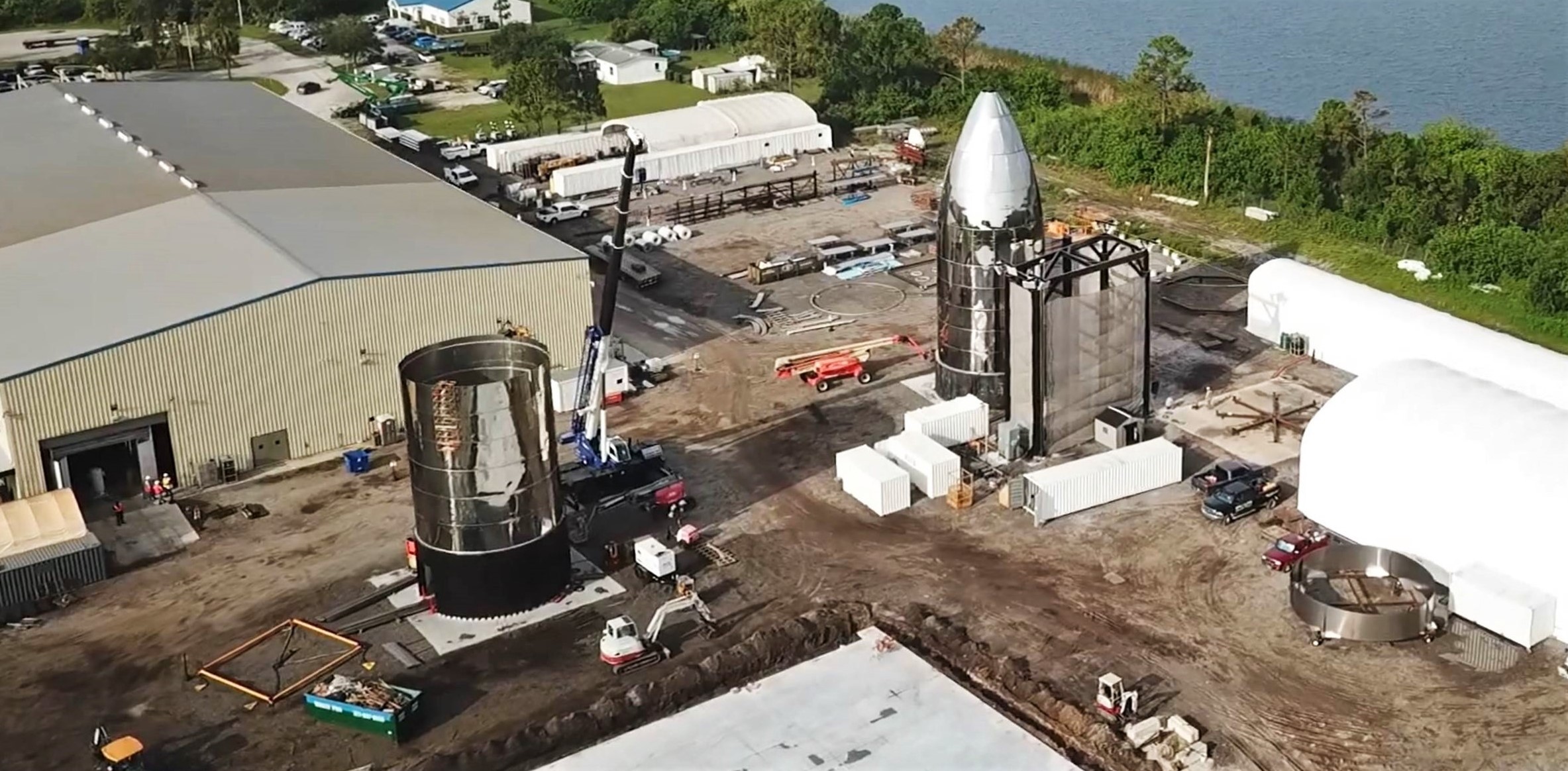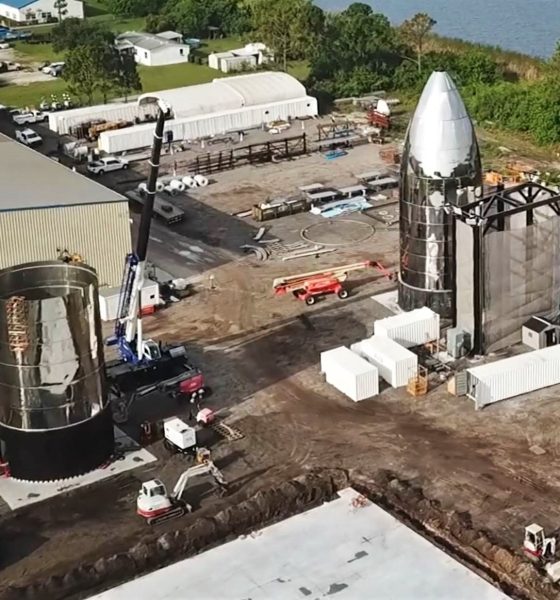

News
SpaceX’s Florida Starship shown off in aerial footage as Texas prototype grows rapidly
Local amateur photographer and spaceflight fan Michael Tapes has graciously shared a new aerial view of SpaceX’s Florida Starship facility, where dozens of workers can be seen buzzing around what is hoped to become the first orbital-class prototype of the massive spaceship and upper stage.
Tapes’ aerial footage offers a unique look at the layout of SpaceX’s Florida site as of July 9th, illustrating just how active and expansive it is. Some workers can be seen building something (perhaps preparing a new worksite) under a large, white tent, while another group surveys two large Starship segments and a third works to prepare new stainless steel ring sections. Of note, those two large Starship segments appear to be bereft of any obvious activity, perhaps a consequence of a fire that caused about $100,000 in damage the day prior (July 8th).
In fact, the shipping container that took what looks like the entirety of fire-related damage is visible on the west side of the SpaceX facility’s main hangar. Workers could be seen heading inside the extremely scorched container, likely removing debris, cleaning up the site of the incident, and preparing to scrap the damaged container itself.
Thankfully, nobody was injured by the fire and ~$100K of damage is certainly an inconvenience but is definitely nothing more for a multibillion-dollar company like SpaceX. Given that dozens of vehicles are visible in the parking lot, it’s safe to say that tons of work is ongoing under the roofs of the site’s many covered buildings, potentially designing Starship/Super Heavy, working on the rocket’s first orbital-class thrust structures, building new steel ring segments, and much more. With any luck, work on orbital Starship assembly and integration has already resumed following the small July 8th fire.


Star(ship) Wars
Speaking of that work, prior to the last week or so of progress on SpaceX South Texas’ own orbital Starship prototype, both Florida and Texas appeared to be more or less tied with two large Starship segments each and various other 9m-diameter subsections spread around their respective facilities. Impressively, Boca Chica has been marked by a flurry of recent work as multiple in-process steel rings were stacked on top of the Texas Starship’s propulsion and tankage section.
In just the last two weeks of June, workers thus pushed through the brutal South Texas heat and humidity to stack three new sections of fuselage, literally doubling the height of Boca Chica’s (hopefully) orbital-class Starship prototype in a dozen or so days. The ship’s conical nose section continues to be polished, while some sort of additional work is likely going on inside, away from public view. It’s hard to get a good overhead view but it’s safe to assume that – in the large barrel sections both in Florida and Texas – technicians are working to install (or at least prepare for) stainless steel tank domes, one of the last major finishing touches for spacecraft’s tank sections.
A huge amount of work remains for both sites but the visible progress as new ship segments are stacked and welded together is undeniably cathartic and satisfying. Working 10-12 hour shifts exposed to the Texas and Florida summer sun, heat, and wildlife is in no uncertain terms bound to be a hellish experience, but at least the hard work is so obviously producing results.
The most exciting kind of grass-watching
Back in Florida, several additional Starship barrel sections are in various stages of work, at least two of which appear to be nearly ready for stacking atop the propellant tank section already being assembled. Meanwhile, propellant tank domes were spotted in different stages of fabrication inside the Florida facility’s main hangar-cum-production-line, awaiting their turn to leave the building and prepare for installation on Starship East.
All said and done, once those visible segments are installed, Starship East will (at least by appearances) be neck and neck with its Texas sibling once more. In reality, there is likely no actual race between the two sites and they are reportedly sharing any critical discoveries and lessons-learned. Nevertheless, humans are notoriously competitive and one can only begin to imagine the (hopefully friendly) rivalry forming between the geographically distinct teams.



At the same time, SpaceX’s Florida team has several home-field advantages, so to speak, owing to their proximity to the several hundred SpaceXers working at the company’s Florida launch facilities and recovery fleet. Additionally, Florida’s Starship facility is just a few dozen miles away from SpaceX’s Kennedy Space Center Pad 39A, the most likely site of Starship’s (and Super Heavy’s) first suborbital and orbital launch attempts.
At the end of the day, a little friendly internal competition and – more so – a literal Starship A/B test are bound to be a huge benefit for SpaceX’s next-gen launch vehicle program, significantly increasing the speed at which the company can make mistakes, solve problems, and get Starship ready for orbit.
Check out Teslarati’s Marketplace! We offer Tesla accessories, including for the Tesla Cybertruck and Tesla Model 3.

News
Tesla FSD fleet is nearing 7 billion total miles, including 2.5 billion city miles
As can be seen on Tesla’s official FSD webpage, vehicles equipped with the system have now navigated over 6.99 billion miles.

Tesla’s Full Self-Driving (Supervised) fleet is closing in on almost 7 billion total miles driven, as per data posted by the company on its official FSD webpage.
These figures hint at the massive scale of data fueling Tesla’s rapid FSD improvements, which have been quite notable as of late.
FSD mileage milestones
As can be seen on Tesla’s official FSD webpage, vehicles equipped with the system have now navigated over 6.99 billion miles. Tesla owner and avid FSD tester Whole Mars Catalog also shared a screenshot indicating that from the nearly 7 billion miles traveled by the FSD fleet, more than 2.5 billion miles were driven inside cities.
City miles are particularly valuable for complex urban scenarios like unprotected turns, pedestrian interactions, and traffic lights. This is also the difference-maker for FSD, as only complex solutions, such as Waymo’s self-driving taxis, operate similarly on inner-city streets. And even then, incidents such as the San Francisco blackouts have proven challenging for sensor-rich vehicles like Waymos.
Tesla’s data edge
Tesla has a number of advantages in the autonomous vehicle sector, one of which is the size of its fleet and the number of vehicles training FSD on real-world roads. Tesla’s nearly 7 billion FSD miles then allow the company to roll out updates that make its vehicles behave like they are being driven by experienced drivers, even if they are operating on their own.
So notable are Tesla’s improvements to FSD that NVIDIA Director of Robotics Jim Fan, after experiencing FSD v14, noted that the system is the first AI that passes what he described as a “Physical Turing Test.”
“Despite knowing exactly how robot learning works, I still find it magical watching the steering wheel turn by itself. First it feels surreal, next it becomes routine. Then, like the smartphone, taking it away actively hurts. This is how humanity gets rewired and glued to god-like technologies,” Fan wrote in a post on X.
News
Tesla starts showing how FSD will change lives in Europe
Local officials tested the system on narrow country roads and were impressed by FSD’s smooth, human-like driving, with some calling the service a game-changer for everyday life in areas that are far from urban centers.

Tesla has launched Europe’s first public shuttle service using Full Self-Driving (Supervised) in the rural Eifelkreis Bitburg-Prüm region of Germany, demonstrating how the technology can restore independence and mobility for people who struggle with limited transport options.
Local officials tested the system on narrow country roads and were impressed by FSD’s smooth, human-like driving, with some calling the service a game-changer for everyday life in areas that are far from urban centers.
Officials see real impact on rural residents
Arzfeld Mayor Johannes Kuhl and District Administrator Andreas Kruppert personally tested the Tesla shuttle service. This allowed them to see just how well FSD navigated winding lanes and rural roads confidently. Kruppert said, “Autonomous driving sounds like science fiction to many, but we simply see here that it works totally well in rural regions too.” Kuhl, for his part, also noted that FSD “feels like a very experienced driver.”
The pilot complements the area’s “Citizen Bus” program, which provides on-demand rides for elderly residents who can no longer drive themselves. Tesla Europe shared a video of a demonstration of the service, highlighting how FSD gives people their freedom back, even in places where public transport is not as prevalent.
What the Ministry for Economic Affairs and Transport says
Rhineland-Palatinate’s Minister Daniela Schmitt supported the project, praising the collaboration that made this “first of its kind in Europe” possible. As per the ministry, the rural rollout for the service shows FSD’s potential beyond major cities, and it delivers tangible benefits like grocery runs, doctor visits, and social connections for isolated residents.
“Reliable and flexible mobility is especially vital in rural areas. With the launch of a shuttle service using self-driving vehicles (FSD supervised) by Tesla in the Eifelkreis Bitburg-Prüm, an innovative pilot project is now getting underway that complements local community bus services. It is the first project of its kind in Europe.
“The result is a real gain for rural mobility: greater accessibility, more flexibility and tangible benefits for everyday life. A strong signal for innovation, cooperation and future-oriented mobility beyond urban centers,” the ministry wrote in a LinkedIn post.
News
Tesla China quietly posts Robotaxi-related job listing
Tesla China is currently seeking a Low Voltage Electrical Engineer to work on circuit board design for the company’s autonomous vehicles.

Tesla has posted a new job listing in Shanghai explicitly tied to its Robotaxi program, fueling speculation that the company is preparing to launch its dedicated autonomous ride-hailing service in China.
As noted in the listing, Tesla China is currently seeking a Low Voltage Electrical Engineer to work on circuit board design for the company’s autonomous vehicles.
Robotaxi-specific role
The listing, which was shared on social media platform X by industry watcher @tslaming, suggested that Tesla China is looking to fill the role urgently. The job listing itself specifically mentions that the person hired for the role will be working on the Low Voltage Hardware team, which would design the circuit boards that would serve as the nervous system of the Robotaxi.
Key tasks for the role, as indicated in the job listing, include collaboration with PCB layout, firmware, mechanical, program management, and validation teams, among other responsibilities. The role is based in Shanghai.
China Robotaxi launch
China represents a massive potential market for robotaxis, with its dense urban centers and supportive policies in select cities. Tesla has limited permission to roll out FSD in the country, though despite this, its vehicles have been hailed as among the best in the market when it comes to autonomous features. So far, at least, it appears that China supports Tesla’s FSD and Robotaxi rollout.
This was hinted at in November, when Tesla brought the Cybercab to the 8th China International Import Expo (CIIE) in Shanghai, marking the first time that the autonomous two-seater was brought to the Asia-Pacific region. The vehicle, despite not having a release date in China, received a significant amount of interest among the event’s attendees.








